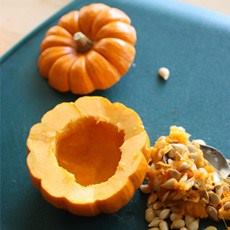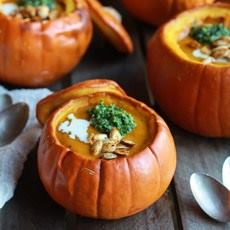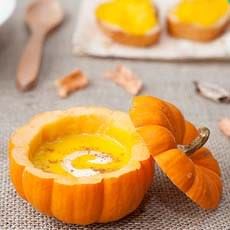|
Express your inner artist by turning miniature pumpkins into bowls for pumpkin soup.
The next fun part is garnishing them with whatever appeals to you. Some of our favorites:
Croutons: cornbread, pumpkernickel or sourdough
Dairy: crème fraîche, sour cream, yogurt
Heat: crushed red pepper flakes, red jalapeno (circles or minced)
Meat: bacon, frizzled ham or prosciutto, pork belly squares
Pesto: cilantro, mint, parsley
Sage Leaves: fresh or fried
Spices: nutmeg, paprika, pimenton
More: apple chips, cranberry relish, currants, pomegranate arils, pumpkin seeds, toasted pecans
Here are some recipes to start you off:
PUMPKIN SOUP RECIPES
Pumpkin Soup With Chicken stock & Milk
Pumpkin Soup With Chicken Stock, Half-And-Half and Cocoa Croutons
Pumpkin Soup With Anise & Pernod-Flavored Cream Cheese “Sorbet”
Pumpkin Soup With Mint Pesto Garnish
Pumpkin Soup With Garnishes Of Fried Pumpkin Seeds & Sage Pesto
Roasted Garlic Sage Pesto Pumpkin Soup with Spicy Fried Pumpkin Seeds
THE DIFFERENCES: BROTH, CHOWDER, SOUP & MORE
Bisque: A thick, creamy soup that traditionally was made from puréed shellfish. Today bisques are also made from fruits, game fish and vegetables.
Broth & Stock: Liquids in which meat, fish, grains or vegetables have been simmered. The difference between a broth and a stock is that broth is made from the desirable ingredients; stock is made from “leftovers” such as bones and skin; thus broth is richer and more nourishing than stock. Both are used as a base for soups and gravies.
Chowder: Chunky soups thickened with flour. The main ingredient chowder can range widely, including chicken, corn, fish and seafood.
Consommé: A broth that has been clarification. This means that egg whites or other ingredients are boiled in the broth to coagulate the sediment, resulting in a clear, elegant-looking soup.
Gumbo: A dish that can fall into the soup or stew category, a strong stock of meat and/or fish/seafood, with pieces of the protein and a variety of vegetables, served over rice. Gumbo is traditionally thickened with okra or filé powder (from the sassfras tree) and vegetables. A gumbo is traditionally served over rice.
Gravy: Gravy is not a soup, but a sauce; although Americans have often turned canned soups into sauces. Gravies are made from the juices of cooked meat or vegetables after they have been cooked. Almost all gravies start with a roux (ROO), a mixture of flour and butter; and are thickened with starch (flour, corn starch, arrowroot, etc).
Purée: Some soups are puréed into smoothness. A purée can be considered a vegetable or grain/pulse counterpoint to a bisque. The technique also produces smooth apple sauce, whipped potatoes and puréed vegetables (carrot purée, broccoli purée, etc.).
Ragout: The French term for a main-dish stew. Note that in Italian, n Italian cuisine, ragù is a meat-based pasta sauce.
Soup: Any combination of ingredients cooked in a liquid base: fish/seafood, fruit, meats, starches and vegetables. Soups can be thick and hearty or thin and delicate. While cooked ingredients can remain in the soup, the objective of the ingredients is to flavor the liquid. Soup can be served warm, room temperature or chilled. Fruit soups can be served for starters or desserts.
|
|




[1] Get a mini pumpkin for each serving (photo courtesy Tablespoon). [2] This recipe has a garnish of mint pesto (photo Annabelle Breakey | Sunset). [3] This recipe has a garnish of sage pesto and fried pumpkin seeds (photo courtesy Half Baked Harvest). [4] This recipe has a simple garnish of creme fraiche* and pimenton* (photo courtesy Noob Cook).
|
|
Stew: A hearty dish made from proteins, vegetables, pulses, etc., simmered in a liquid (water, broth, stock, wine, beer) and then served in the resulting gravy. Stewing is a technique to cook less tender cuts of meat: The slow cooking method tenderizes the meat and the lower temperature allows the flavors to combine. There is a thin line between soups and chunky soups; generally, stews contain less liquid. Sometimes the name is adopted for a soup. Oyster Stew, for example, is a thick soup with butter and milk or cream, like a bisque.
THE DIFFERENT TYPES OF SOUP
THE HISTORY OF SOUP
|